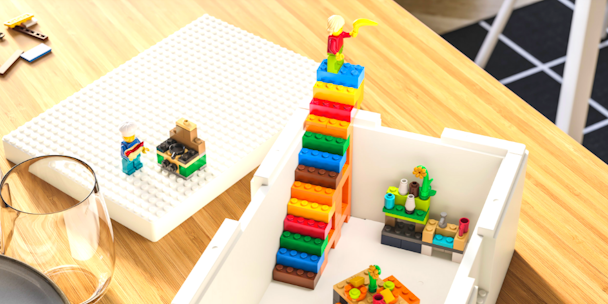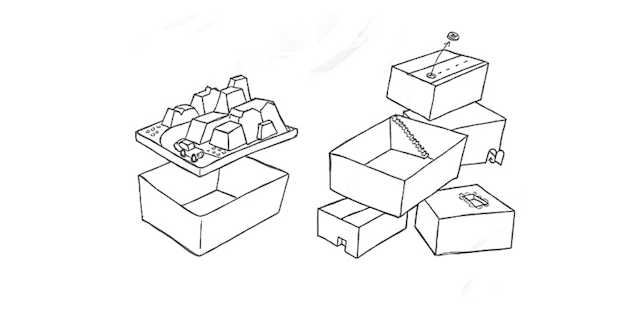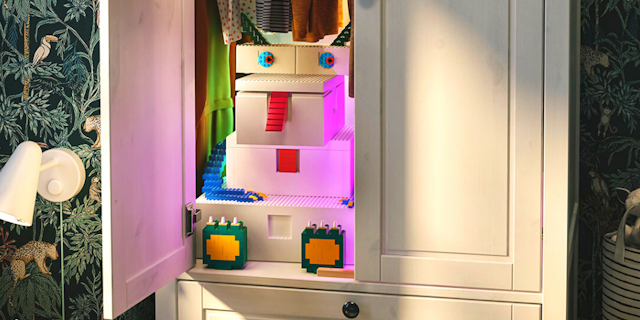
Advertisement

Play, display and replay: How Ikea and the Lego Group developed Bygglek
Lego is well aware that its product encourages mess. Not that it’s necessarily a bad thing, as any decent Lego session ends with bricks and figures all over the floor. To make it easier for parents to cope without stifling creativity, Lego looked to the giants of storage, Ikea. Together they created a simple solution, aptly named ’Bygglek.’
A fun accessory to any household, the communal box of Lego is a realm where children from generation to generation can get to grips with their imagination. Though, as any parent knows, creativity can often mean chaos. After a hard day’s play, treading on an eye-wateringly sharp piece is pretty much inevitable.

So the Lego Group finally decided to find a solution that would allow children to escape into their own imaginations, while making cleaning a part of the creative process.
“We soon realised that Ikea would be the perfect partner, but how do you do that?“ asks Rasmus Løgstrup, head designer at Lego. “Do you just pick up the phone and call the main number?“
Løgstrup recalls how, while struggling to make the right contact at Ikea, a chance encounter at a school board meeting kickstarted the soon-to-be long-term collaboration between the two beloved Scandinavian brands. “By some coincidence, the leader from our licensing department happened to sit next to someone at Ikea and they started discussing the potential project,“ he explains.
Spurred on by this coincidence, the early courtship saw the Lego team invite Ikea to ‘come play‘ by sending them a stop motion movie to spell out the challenge Lego faced. An attractive offer that few could refuse, Ikea designer Andreas Fredriksson notes. “Of course we wanted to play. It was a yes from the beginning. It‘s the perfect match because we work with small space living at home and Lego is all about play.“

The crux of the issue was how to create a product that didn‘t feel like ‘organised fun.‘
“We didn‘t want to organise the play, but make it easier to do so,“ Fredriksson explains. “We also didn't want it to be a product that ends up in the children‘s room by default. It needed to be something nice looking to fit seamlessly in the living room as we wanted the play to be the whole home.“
Løgstrup says how the team looked to existing research to develop their ideas. “Research shows that the searching process is important,“ he says. “We didn‘t want to sort it all out for kids. There‘s something about play that inspires kids when they want to build something and all of a sudden they find a steering wheel or a shark, and the play goes in a new direction. We also found out that kids like to play on the floor.“

And so the designers set about designing a functional box that would encourage play. Løgstrup explains one challenge from Lego‘s perspective. “Our system is like the Coca-Cola recipe. It‘s secret and hard to copy. When designing a product, it is crucial that everything is accurate in order to make everything fit together – which is hard for one of the biggest moulded items in Lego's history. So we knew it would be a bit complex and challenging.“
He admits, however, that the challenge actually made the partnership more valuable. If had it been Lego working on its own, the team might have looked for other solutions at the very beginning. “But having people from Ikea with fresh eyes meant we were working together, asking all the stupid questions: why can‘t we do this? Then you start to challenge yourself. It meant we were able to achieve something we haven't done before,“ he says.

To develop the perfect product, both Ikea and Lego staged workshops where their designers brainstormed various ideas, calling upon their collective resources.“First, the prototypes were created using cardboard. Using the bricks as a starting point, we needed to scale the size. We started to put them on top of each other which was really eye-opening,“ recalls Fredriksson. “We started to realise that this could be something that is part of the play, not just a storage device.“

With prototypes finally developed, Ikea and Lego set about testing them out on their target audience. “We trialled them at Ikea with different children, to see how they played with it,“ says Lego‘s Løgstrup. “The first test was with a five-year-old who stacked the boxes on top of each other and turned them into a cake, and then went out into the kitchen to find some biscuits and candy,“ he recalls. “We also sent out in-home tests to trial the boxes in situ.“
Consisting of a series of storage boxes adorned with Lego studs and a special Lego brick set, the solution will be available from October. The storage unit has been aptly named ‘Bygglek‘, Swedish for ‘build, play‘, meaning the set sits snugly with Ikea‘s ingenious product naming system.

According to Løgstrup, the product marks the beginning of a long-term collaboration between Ikea and Lego. “You will have to see what happens in the future,“ he says.
“This is just the starting base. The Bygglek is meant to be a lasting product, its the way it‘s been designed. It‘s something that you can collect and pass on to the next generation.“